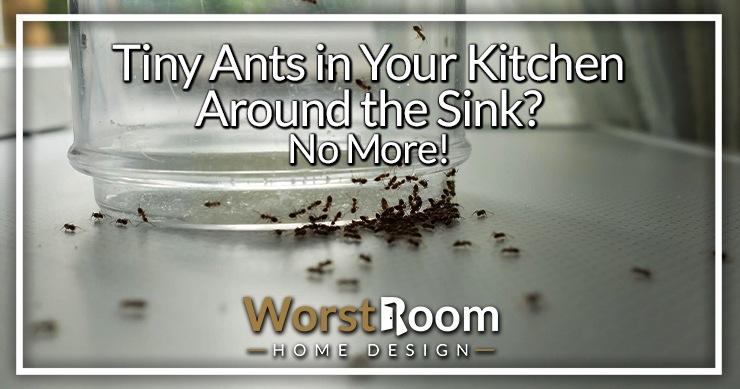
Finding tiny ants in your kitchen around the sink is common. Many homeowners become frustrated when they see one or two of these insects in the kitchen, only to have more followers. Thankfully, there are ways to help prevent these miniature visitors and eliminate them for good.
From homemade remedies to hiring professional exterminators, how you handle ants in your home will depend on the size of your problem.
You are watching: Tiny Ants in Your Kitchen Around the Sink? No More!
Why Do Tiny Ants Appear in the Kitchen?
Ants will enter a home when they are looking for food and shelter. They are small enough to go through cracks in the door and window frames or tiny breaks in the foundation. They’re looking for crumbs of food, meaning you can find ants in your carpet (especially if you have carpet in your kitchen), on your countertops, and even in your pantries.
If ants are lucky enough to find a food or water source in your kitchen space, they will alert the rest of the colony. So, you can have the number of ants grow quickly if you don’t address the problem immediately.
Rooms like the kitchen are a favorite spot for these little critters. This room often has increased moisture, providing a better place for them to thrive. Although ants are less active in the cold winter months, they can still invade your home year-round, depending on your climate.
What To Do About Tiny Ants in the Kitchen Around the Sink
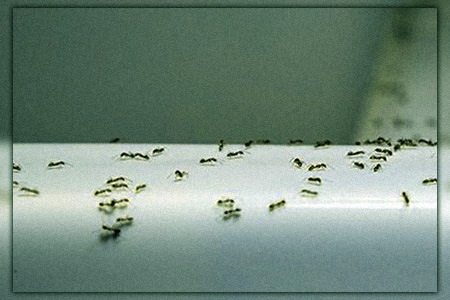
You must immediately take action if you notice tiny ants on your kitchen counters or around the sink. These insects will not go away on their own and will quickly multiply to create a bigger problem.
Thankfully, there are several things you can do to tackle these pests without spending money on a professional exterminator if you don’t need to. Follow these five simple steps to manage tiny ants in your kitchen, around the sink, and on the counter.
- Find where the ants access the kitchen
- Locate the colony’s nest
- Destroy the nest
- Seal up access points
- Remove food sources
As always, I recommend reading through the entire procedure once before you get started so you know what to expect and don’t make any mistakes. There’s nothing that wild going on here, but it’s good practice.
Step 1: Find Where the Ants Access the Kitchen
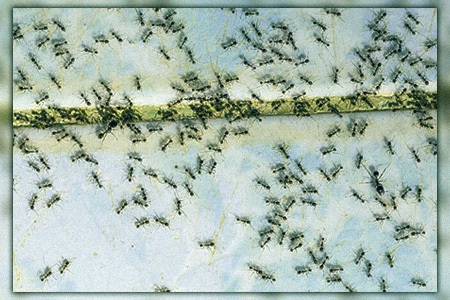
If you don’t know where the tiny ants in the kitchen around the sink are coming from, it will be harder to get rid of them. You may have to watch their moments for a few minutes and see where they travel. Some common places that you should examine for ants include:
- Broken or torn window screens
- Missing or peeling caulking around window or door frames
- Cracks in the walls or floors
- Cabinets installed on an exterior wall
These access points are just a few likely ways tiny ants enter your home. So note any place you see or suspect these insects are using to reach your kitchen. You can caulk over caulk, so don’t think it’s a big job to seal off those cracks.
Step 2: Locate the Colony’s Nest
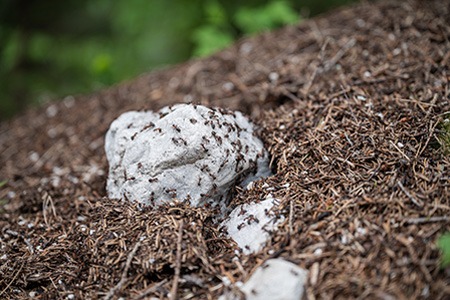
Now that you’ve found tiny ants on the kitchen counter and watched them travel around your kitchen, next locate the colony’s nest. An ant colony can vary from 20,000 to 100,000 ants, making an infestation seem impossible to control.
Read more : Small Kitchen Paint Colors: 2023 Trends
Killing ants when you see them is an ineffective solution if a thriving colony remains nearby. When you squish an ant, it releases pheromones that alert the other ants in the colony. Therefore, killing the few ants you see on your kitchen counter will attract more to your home.
If you are fortunate enough to watch these insects, they may lead you right to their nest. It could be inside your home or outdoors, so this step may take some searching. Some tips for locating an ant’s nest are:
- Observe groups of ants traveling rather than one at a time
- Look for a pile of wood shavings, sawdust, or dirt particles
- Search for dead ants around window sills, baseboards, or in remote corners
Of course, if you cannot find the colony, you may need the help of a professional exterminator. This way, you can avoid a re-infestation later.
Step 3: Destroy the Nest
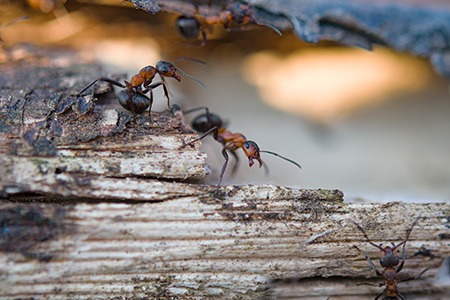
Once you locate the ant’s nest, you must destroy it completely to permanently get rid of the tiny ants in the kitchen around the sink. Although it isn’t difficult, some ways are better than others to ensure the ants are gone. Some methods to kill an ant’s nest include:
- Pour a pot of boiling water into the ant hill
- Sprinkle diatomaceous earth on the ant hill, around access points, and anywhere you see ants
- Put a small amount of boric acid on the ant hill
- Use pepper or cinnamon to deter ants
- Spray a vinegar solution on the hill and around any active areas
- Apply over-the-counter pesticides or traps
Always ensure you wear protective footwear and gloves when taking care of an infestation of tiny ants in your ktichen. Tucking your pants into your shoes will keep ants from climbing up your feet and legs. Using eye protection and a mask is helpful when using diatomaceous earth to prevent any eye or skin irritation.
Boiling Water
An ant hill can stretch deep into the ground, up to seven feet. You can use a large pot of boiling water to destroy a nest naturally. Carefully pour at least half a gallon of water into the top of the colony’s nest. The boiling water will help collapse the nest and kill the ants inside.
Diatomaceous Earth
You can find food grade diatomaceous earth to rid your home of troublesome ants easily. This powdery substance comes from phytoplankton fossilized remains. The sharp edges cut the ant’s exoskeleton, causing it to dry out and die.
Sprinkle this powder on the ant hill and around any high-traffic areas, baseboards, and along their access points. Always be careful not to breathe it in or get it on your skin since it is irritating when inhaled or with skin contact.
Boric Acid

Boric acid powder is toxic to ants but carries low toxicity for humans, but it should be stored away from kids and pets when not in use. This substance works well for killing ants indoors or outside.
Just apply a thin layer of boric acid powder on top of the ant’s nest and around access areas. You can reapply more powder as necessary until all the ants are gone.
Another popular ant control method is mixing one-part boric acid powder with one-part icing sugar. The sweetness of the sugar will attract these insects, and the boric acid powder kills them once ingested. You can sprinkle this mixture around access points, over the colony’s hill, through traffic areas, and leave small dishes full for the ants to consume.
Pepper or Cinnamon
Read more : How To Reset Your KitchenAid Dishwasher
Black or cayenne pepper and cinnamon are excellent natural deterrents for the tiny ants in the kitchen around the sink. These insects don’t like the smell and will move away from areas where it’s present. So shake a generous amount of cinnamon or pepper around an ant hill, popular travel areas, and nearby access points to keep ants from entering your home.
Vinegar Solution
Vinegar is a natural disinfectant that can cover up any pheromone trails ants leave on their travels. In addition, these insects don’t like the smell of vinegar, which is an excellent deterrent for troublesome ants.
Mix one-part water with one-part white vinegar in a spray bottle and spray the areas where you see ants, suspected access points, and on and around the ant hill.
Pesticides & Traps
Although commercial pesticides and ant traps do not destroy the entire colony, they can minimize the number of ants around the sink drastically. However, this ant control method will only be successful once you block any access points and keep these insects away permanently.
Step 4: Seal Up Access Points
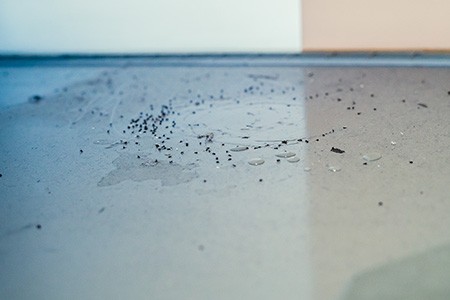
The best way to manage an ant infestation is to prevent it from happening. You want to ensure these tiny ants cannot enter your home by sealing up any current access points. Some areas that you should consider sealing are:
- Cracks or holes in the home’s exterior foundation
- Broken door and window frames
- Locations where wires or plumbing enters the home
- Gaps in floor materials
When you eliminate these easy access points, insects have more difficulty entering your kitchen. You can place some plants that repel ants in your window sills, which is a common point of entry, too.
Step 5: Remove Food Sources

Once you rid your home of ants and eliminate the nest, you want to remove any food sources that may attract insects back to your home. For example, ants love sweet foods, and all items in your kitchen should be in air-tight containers to prevent these visitors from reaching your goods.
You should relocate cereal, bags of sugar, and other dry goods into plastic or glass containers for optimal protection against an ant infestation.
Very Tiny Ants Around Your Kitchen Sink & the Kitchen Counter
However, if you aren’t comfortable using these natural methods of eliminating ants from your home, a professional can handle the job, regardless of size. You must remember the sooner you tackle the problem of getting rid of ants, the easier it will be.
So, whether you want to manage an infestation by yourself or call professionals, keeping tiny ants out of your kitchen for good is possible.
Seeing tiny ants in the kitchen around the sink and on the counter can make you nervous. No homeowner enjoys insects invading their home. However, if you don’t address your ant problem as soon as possible, it can grow substantially, resulting in a call to a professional exterminator.
You’ll Also Enjoy:
- How To Get Rid of Wasps With Vinegar & Vengeance
- 21 Plants That Repel Ticks: Fresh Smells We Love & Ticks Hate!
- 14 Plants That Repel Spiders Indoors & Outdoors With Little Effort
- 7 Plants That Repel Fleas & Provide Secondary Benefits You’ll Love
- 10 Plants That Repel Mosquitos in Your Yard & Indoors
Source: https://gardencourte.com
Categories: Kitchens


